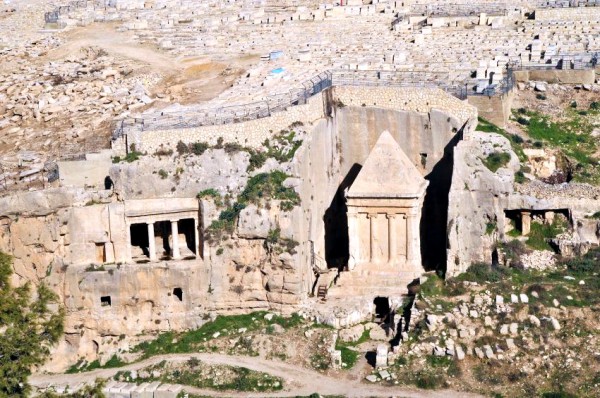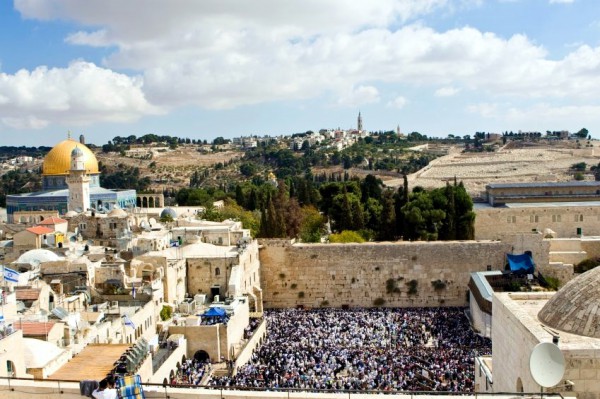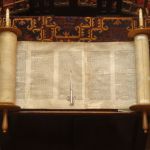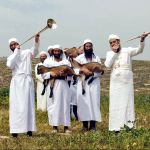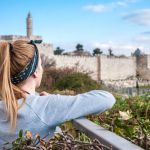
A view of the Mount of Olives, a mountain ridge to the east of the Temple Mount with three peaks running from north to south. The highest, at-Tur, rises to 818 meters. It is named for the olive groves that once covered its slopes.
“Yeshua went out as usual to the Mount of Olives, and His talmidim [disciples] followed Him.” (Luke 22:39)
One of the sites Yeshua (Jesus) frequently retreated to while in Jerusalem was the Mount of Olives (Har HaZeitim),
This mighty hill is also called the Mount of Anointing (Har HaMishcha) because olive trees that lined its slopes were used to produce the olive oil that anointed kings 3000 years ago.
Yeshua, the King of Kings, who has been anointed by God Himself, enjoyed prayer, solitude, and fellowship here.
It was from atop this mountain that He revealed to His talmidim (disciples) the events of the Last Days (Matthew 24:1–51) in what has come to be known as the Olivet Discourse or Olivet Prophecy.
Yeshua rode down the Mount of Olives on a donkey during His Triumphal Entry into Jerusalem (Luke 19:28-44).
It was here that He was betrayed and arrested (Luke 22:39-46).
And from this mountain, He ascended into Heaven (Acts 1:1-12).
Immediately afterward, the angels told the talmidim that Yeshua would also return here:
“Men of Galilee,” they said, “why do you stand here looking into the sky? This same Yeshua, who has been taken from you into Heaven, will come back in the same way you have seen Him go into heaven.” (Acts 1:11)
And the Prophet Zechariah described in detail how He would arrive:
“On that day His feet will stand on the Mount of Olives …” (Zechariah 14:4)
Christians understand this prophecy to refer to the arrival of Yeshua, who is the physical manifestation of the LORD.
Join us now for a brief tour of these events and more as we journey to the Mount of Olives in Jerusalem.
The Shekinah Glory of God on the Mount of Olives
The Prophet Ezekiel who was taken into Babylonian exile around 597 BC foresaw that God’s glory would one day leave the Temple and rest on the Mount of Olives.
“The glory of the LORD went up from within the city and stopped above the mountain east of it.” (Ezekiel 11:23)
Rabbi Jonathan, who witnessed the Roman conquest of Jerusalem in AD 66–70, wrote that the Shekinah glory of God did indeed leave the Temple in AD 66 and moved to the Mount of Olives.
He said that the Lord’s presence “abode on the Mount of Olives hoping that Israel would repent, but they did not; while a Bet Kol [a supernatural voice] issued forth announcing, ‘Return, O backsliding children [Jeremiah 3:14]. Return unto Me, and I will return unto you [Malachi 3:7].’ When they did not repent, it said, ‘I will return to My place [Hosea 5:15].'” (Midrash Rabbah, Lamentations 2:11)
According to Jewish tradition, then, the Presence of God atop the Mount of Olives left in AD 70, four years after it arrived because His children would not repent and return to Him.
In that same year, historical records tell us that Romans razed Jerusalem and destroyed the Temple. Not one stone was left atop another, just as Yeshua prophesied.
On Shavuot (Pentecost) 40 years earlier, God had already made His Spirit available to all Believers in Yeshua as Messiah and as their Salvation (Acts 2).
Millions of Jewish People are still seeking that Salvation, crying out for it from atop the Mount of Olives.
Seeking Salvation on the Mount of Olives
In the 13th century, pilgrims began a tradition on the Mount of Olives during the feast of Sukkot (Feast of Tabernacles).
They ascended the top of the Mount and circled the summit in a parade of song and celebration—one circle each day for the first six days of the Feast. This symbolized the Temple service in which the priests circled the altar once a day during the seven-day feast.
The last day of the Feast is called Hoshana Rabbah (Hosanna in the Highest or the Great, Save Us Now).
On this day of seeking Salvation, the procession circled the summit seven times, just as the priests used to circle the Temple altar seven times. Then Jews around the world and the pilgrims atop the Mount of Olives cry out for salvation:
“Save us, we pray, O LORD! O LORD, we pray, let us thrive! Blessed is He who comes in the name of the LORD! We bless you from the house of the LORD.” (Psalm 118:25–26)

Worshipers carrying their lulav and etrogs (citrons) on Hoshana Rabbah atop the Mount of Olives sing prayers of Hoshanot (plural for Save Us). (Source: YouTube Capture)
Although in Jewish tradition, judgment of a person’s sins is rendered on the Day of Atonement (Yom Kippur), tradition also states that Hoshana Rabbah is the day when God finalizes His judgment on each person.
Indeed, when the Jewish People’s prayers are answered, and the LORD steps atop the Mount of Olives, He will not only bring salvation to those who believe in Him, He will make His judgment on all people final (Joel 3:12 [4:2]; Zechariah 14:1–4).
Yeshua HaMashiach (Jesus the Messiah, our Salvation) will fulfill all these expectations and prayers when He returns to the Mount of Olives with the trumpet call of God:
“For the Lord Himself will come down from heaven, with a loud command, with the voice of the archangel and with the trumpet call of God, and the dead in Yeshua will rise first.
After that, we who are still alive and are left will be caught up together with them in the clouds to meet the Lord in the air. And so we will be with the Lord forever.” (1 Thessalonians 4:16–17; see Acts 1:10–11)

The seventh and final shofar that we read about in the Book of Revelation will sound when Yeshua returns to Jerusalem, hailing him as King Messiah.
Yeshua’s Triumphal Entry into Jerusalem
The Mount of Olives has already played a role in the salvation of the Jewish People, indeed of all mankind.
In the final year of His first coming, just before Pesach (Passover), Yeshua left Bethpage (the house of unripe figs) near Bethany (the house of dates), which are located on the east side of the Mount of Olives.
He went over the Mount, humbly descending toward Jerusalem on a donkey, just as Zechariah prophesied about 500 years earlier:
“Shout aloud, O daughter Jerusalem! Lo, your king comes to you; triumphant and victorious is He, humble and riding on a donkey, on a colt, the foal of a donkey.” (Zechariah 9:9)
Overlooking the city that Lamentations calls “the joy of all the world” and a people whom God calls “the apple of His eye,” He wept for God’s people, saying, “If you only knew today what is needed for shalom [peace]! But for now it is hidden from your sight.” (Luke 19:42)
Yeshua understood that many of God’s cherished children would fail to recognize that He is the Messiah promised in Scripture.
Yeshua also foresaw the destruction that would happen as a result of their rejection and prophesied:
“For the days are coming upon you when your enemies will set up a barricade around you, encircle you, hem you in on every side, and dash you to the ground, you and your children within your walls, leaving not one stone standing on another—and all because you did not recognize your opportunity when God offered it!” (Luke 19:43–44)
So many of God’s Chosen People blindly missed the opportunity for true inner peace that Yeshua offers, but in these Last Days as the time of the Gentiles ends, we see that blindness lifting, just as Yeshua prophesied would happen in full one day:
“For I tell you, you will not see Me again until you say, ‘Blessed is He who comes in the name of the Lord.'” (Matthew 23:39)
In Israel, there are now about 25,000 Jewish Believers worshiping Yeshua as their Messiah in over 250 Messianic congregations. But the vast majority of Israel’s seven million Jewish people still do not know Yeshua, and far too many have even rejected God.
We must not think, however, that every Jewish person rejected Yeshua. There have always been Jewish Believers in Yeshua and many Jewish people followed Him in the days of His First Coming.
As He crossed the Kidron Valley and entered Jerusalem, crowds laid their cloaks on the road in front of Yeshua as well as leafy branches they had cut from the trees (thought to be Palm branches) shouting,
“Hosanna! [Save us now!] Blessed is He who comes in the name of the Lord! Blessed is the coming kingdom of our father David! Hoshana Rabbah! (Hosanna in the highest!)”
They understood that by riding into Jerusalem on a donkey, He was fulfilling Zechariah’s prophecy (chapter 9, verse 9).
Resting and Rising on the Mount
In Judaism, it is believed that the resurrection of the dead will begin on the Mount of Olives. If true, those buried here have, in effect, front-row seats to both the coming of Messiah and the resurrection of the dead:
“There shall be a time of trouble, such as never has been since there was a nation till that time. But at that time your people shall be delivered, everyone whose name shall be found written in the book.
“And many of those who sleep in the dust of the earth shall awake, some to everlasting life, and some to shame and everlasting contempt.” (Daniel 12:1–2)
The chalk and flint of the Mount of Olives has been chiseled and crafted into a variety of burial caves and chambers.
The most ancient burial plots are on the southern slope, dating back 3,000 years to the time of the first Temple. More caves and burial monuments line the mountain spreading northward, with the tombs of Zechariah and Absalom at the foot of the Mount.
During the Middle Ages, burials lined the eastern slope of the Temple Mount. As space filled, graves continued to be laid across the Kidron Valley and eventually up the western slope of the Mount of Olives.
Today, there are 122,000 known graves on the Mount, with about 25,000 plots available, according to the Mount of Olives Information Center.
Each available plot is estimated to cost an average of $30,000, with locations near famous rabbis and Jewish leaders demanding higher rates.
The Mount of Olives Under Occupation and Its Aftermath
When Israel’s War of Independence ended in 1949, Jordan had taken control of East Jerusalem, including the Temple Mount and Mount of Olives.
From 1949–1967, about 38,000 graves were desecrated when Jordan’s King Hussein approved the building of the Intercontinental Hotel at the summit of the Mount.
Four roads, parking lots, and a filling station were built over and through cemeteries. Tombstones were relocated and used as paving stones or placed inside Jordanian army latrines.
After the Six Day War of 1967, Israel regained control over the Mount, although it now had a heavy Muslim presence. In 2012, Israel opened a police station here that can dispatch up to 20 officers, as needed.
Why? Because Arab teens have made a dangerous game of throwing large rocks at cemetery visitors and at the taxis coming into the cemeteries. They have also thrown Molotov cocktails (bottle bombs) at vehicles bringing families to and from the 110+ Jewish homes in the Ma’ale Zeitim (Olive Heights) and Ma’alot David (Heights of David) neighborhoods on the Mount. The homes themselves have also been attacked.
In addition to opening a police station, Israel has restored thousands of graves destroyed during the Jordanian rule and opened a tourist information center on the Mount.
Breathtaking views and an amazing spiritual heritage draw tourists to stay in hotels or short-term apartment rentals on the Mount, not realizing the personal safety issues that exist.
As on any foreign excursion, tourists seeking to commune with God on the Mount should keep valuables hidden and walk in pairs or groups to avoid pick-pocketing and other petty crimes that have also become common occurances here.

Because the Mount of Olives is associated with Jewish and Christian traditions, it has a variety of churches and other important sites.
Communing With God on the Mount of Olives
“Hear the voice of my pleas for mercy, when I cry to you for help, when I lift up my hands toward Your most holy sanctuary.” (Psalm 28:2)
During His ministry, Yeshua often came to the Mount of Olives and to the Garden of Gethsemane (Oil Press in Hebrew), where He talked with God alone.
Today, the official garden site is located at the base of the Mount, across from the Dung Gate of the Old City, with easy walking access on the main street that leads into the Mount.
Though the olive trees here have been dated at 900-years-old, they all have the DNA of one parent tree, perhaps the one that Yeshua Himself knelt under to commune with our Father in Heaven.
At His final Passover Seder (meal), after sharing the Passover matzah (unleavened bread) and wine, Yeshua walked across the Kidron Valley and into the garden, a distance the Bible describes as roughly 2,000 cubits (3,000 feet).
Knowing that He would soon become the final Passover Lamb, He earnestly prayed while in the Garden for another way to offer salvation to the world—for the agonizing death that lay before Him to be replaced with something else.
Just as Daniel, Jonah, and many others did and still do when they pray, Yeshua would have prayed facing the Temple, which is the seat of God’s Kingdom on Earth, the very Kingdom that He came to prepare in order to save the people.
Understanding His mission, Yeshua revealed His love for us by following the plan of salvation ordained for Him alone since the time of creation in another garden called Eden.
There, in Eden, God Himself prophesied to Satan that one of Eve’s seed would crush his head, destroying the death sentence over man forever (Genesis 3:15).
That seed is our Salvation, Yeshua.
Yeshua picked up the ear of the servant that Peter had cut off and placed it back in place, healing him.
He said to Peter, “Put your sword away! Shall I not drink the cup the Father has given me?” (John 18:11)
Even after experiencing firsthand the miraculous healing power of Yeshua, the soldiers and religious leaders led Him down the Mount and back to town as a prisoner.
Yeshua Gives Us Signs of His Return
Jewish People pray every day for the coming of the Messiah. The Tanakh (Old Testament) makes it clear that He will come to the Mount of Olives (Zechariah 14:4).
Many believe that building the Third Temple is a prerequisite of His return (Daniel 9:27; 2 Thessalonians 2:3–4).
However, on the Mount of Olives, Yeshua prophesied other signs of His return as well (Matthew 24:1–25:46; Mark 13:1–37; Luke 21:5–36):
These signs include the following:
- Famines and earthquakes in various places,
- Wars and rumors of wars,
- False Messiahs doing signs and wonders that impress even Believers,
- People being hated and killed, turned in by parents and children for Believing in Yeshua,
- The “Abomination of Desolation” (the anti-Messiah) standing in the Temple (see also Daniel 9:27),
- A time of great tribulation and trouble for the Jewish People, and
- Celestial signs.

Yeshua predicted celestial signs would occur before His return. The Earth experienced a cycle of four Blood Moons in 2014–2015 that coincided with Passover and the Feast of Tabernacles. This “coincidence” is rare and has in the past signaled major events for the Jewish People and Israel.
The Anointed One Comes Again to the Mount of Anointing
Jews and Christians alike pray for fulfillment of prophecies that tell us that the Lord will come to the Mount of Olives to usher in His Messianic Kingdom, where there will be no more Molotov cocktail attacks, fears, or tears.
But before He comes, we can expect a devastating war from the surrounding nations, which is being plotted even now.
“A day of the Lord is coming, Jerusalem, when your possessions will be plundered and divided up within your very walls. I will gather all the nations to Jerusalem to fight against it; the city will be captured, the houses ransacked, and the women raped. Half of the city will go into exile, but the rest of the people will not be taken from the city.” (Zechariah 14:1–2)
The great army of Israel that recaptured Jerusalem in six days will have God’s supernatural help again to defeat the enemy in this coming battle:
“Then the Lord will go out and fight against those nations, as He fights on a day of battle.” (Zechariah 14:3)
The punishment to those who come against Jerusalem will be shocking, possibly reminiscent of the scene in Raiders of the Lost Ark when Nazi scavengers dared to open the Ark of the Covenant.
“Their flesh will rot while they are still standing on their feet, their eyes will rot in their sockets, and their tongues will rot in their mouths.” (Zechariah 14:12)
Yet, we can also be sure that His coming will be glorious and in full view of everyone in the world:
“Behold, he is coming with the clouds, and every eye will see Him, even those who pierced Him, and all tribes of the earth will wail on account of Him. Even so. Amen.” (Revelation 1:7)
“On that day His feet will stand on the Mount of Olives, east of Jerusalem, and the Mount of Olives will be split in two from east to west, forming a great valley, with half of the mountain moving north and half moving south.” (Zechariah 14:4)
When His feet touch the Mount of Olives, He is coming back for a redeemed community comprising Jew and Gentile.
Come, Lord Yeshua. Come!










